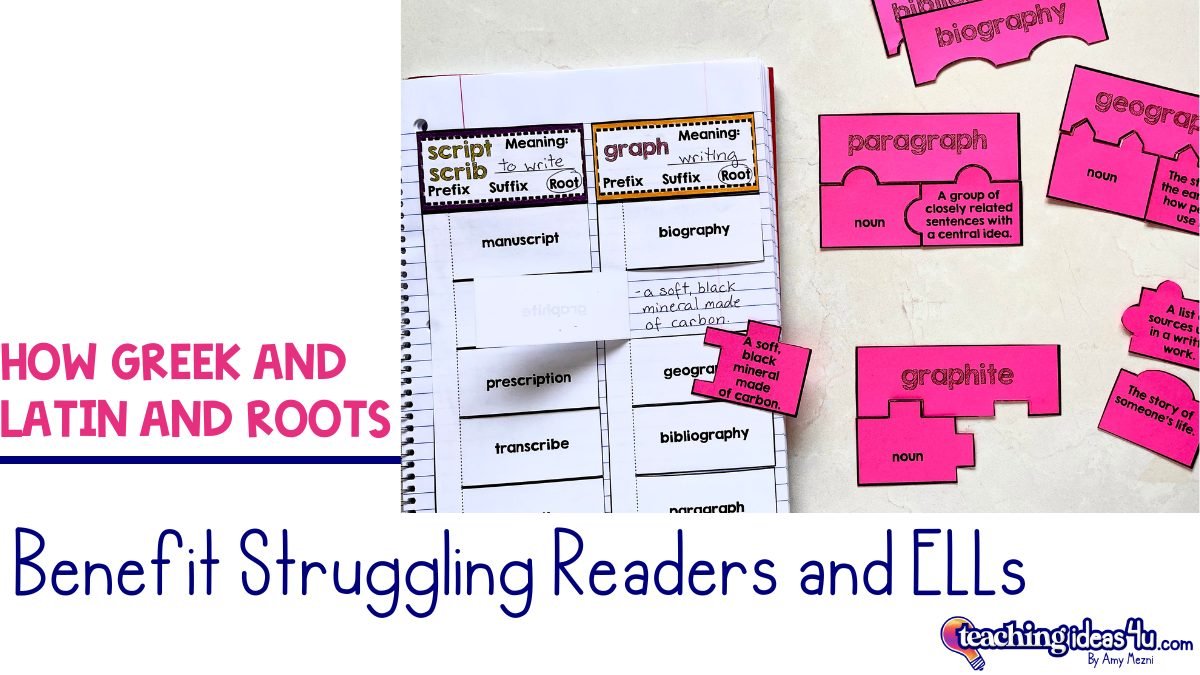How Greek and Latin Roots Benefit Struggling Readers and ELLs
Are you searching for effective strategies to support English Language Learners (ELLs) and struggling readers in your classroom? Explore the benefits of teaching Greek and Latin morphology as a way to bridge language gaps, boost vocabulary skills, and build reading confidence.
Whether the students are English Language Learners (ELLs) or have learning issues such as dyslexia or vision processing disorders, direct instruction in Greek and Latin roots and affixes can help these students improve both their reading comprehension and vocabulary.
Builds Bridges and Foundations for ELLs
English Language Learners face unique challenges when it comes to acquiring language proficiency and developing reading skills. Some ELLs have not had consistent schooling in their country, which can make it difficult to learn a second language. Others have not had much exposure to English at home, as the family speaks in their native language. Some ELLs may also have a learning disability, which is masked by the language barrier.
Greek and Latin roots offer a bridge between ELLs’ native language and English. When native languages share roots with Greek and Latin, ELLs can leverage their existing knowledge to make connections and understand English words more easily. Even if their home language is different from European languages, by teaching ELLs the meanings of common roots, we provide them with a foundation upon which they can build new vocabulary.
For example, if a student speaks Spanish, French, or Portuguese, their language is a Romance language and derives from Latin. Relating English words with Latin morphology may help students to create connections between English and words in their first language.
Other ELLs can use morphology to make connections between related words in English. If students learn that -ology indicates the study of, they can understand an unfamiliar word with that ending will be related to the study of something.
Understanding the meanings of roots and affixes helps these students chunk new words and take an educated guess at their meanings. This not only accelerates their vocabulary growth but also boosts their overall language comprehension and fluency.
Unlocks Reading Potential for Struggling Readers
For students facing reading difficulties, the journey to becoming proficient readers can feel like climbing Mount Everest. Greek and Latin roots can be a game-changer in their literacy development. By teaching these roots, prefixes, and suffixes explicitly, we equip struggling readers with a valuable tool for decoding unfamiliar words.
Students with dyslexia and vision processing issues often need repeated direct instruction of language rules. Learning the meaning of Greek and Latin word parts helps these students remember new vocabulary words, because they can relate it to words they already know.
The ability to recognize familiar word parts within complex words enables students to break down and understand the meanings of these words. Increasing their ability to recognize word parts enhances their reading fluency, word recognition, and ultimately, their reading comprehension.
Enhances Vocabulary Skills
One of the key advantages of teaching Greek and Latin roots is their ability to expand students’ vocabulary in a meaningful way. Morphology instruction is beneficial for all students, including ELLs and struggling readers.
Greek and Latin roots provide a solid foundation for acquiring new words, as many English words are derived from these roots. By understanding the meanings of common roots, students can infer the meanings of related words, which increases their reading comprehension.
Boosts Self-Confidence and Motivation
For ELLs and struggling readers, the journey to becoming proficient readers can be filled with frustration and self-doubt. Incorporating Greek and Latin roots into their learning experience can foster a sense of accomplishment and boost self-confidence.
As students develop their morphological awareness, they feel more confident in their reading abilities, which translates into increased motivation and engagement. By unlocking the power of roots, we provide them with a pathway to success.
Teaching Greek and Latin roots is not just about improving vocabulary or reading comprehension — it's about empowering our students to overcome language barriers, gain confidence in their reading abilities, and embrace the joy of learning. By directly teaching roots and affixes, we can make a significant impact on the literacy journey of struggling readers and English Language Learners.

